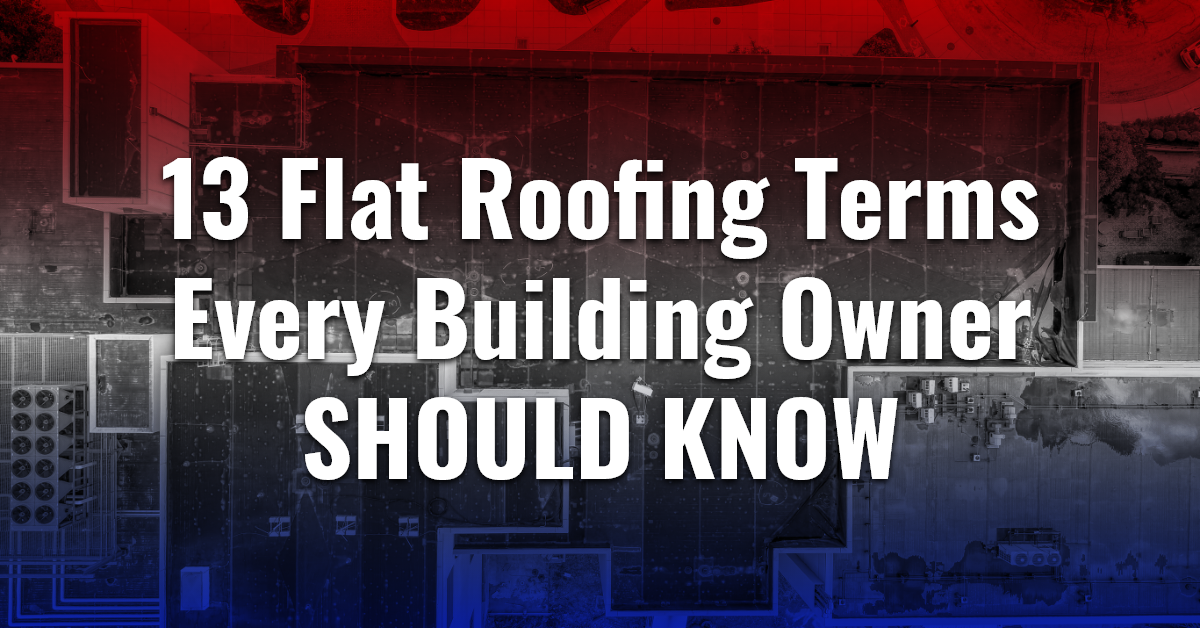When you’re new to owning or managing a commercial property, you don’t want to sound unprofessional. Yet when you chat with your facilities team or your commercial roofer, keeping up with flat roof terminology may be difficult. Never fear! Here are 13 roofing terms specific to low-slope, or flat roofing, to help you better understand your roof, your colleagues, and your roofer.
1. BUR
BUR or Built-up Roofing is an Old School method that still delivers reliable, modestly priced roofing for industrial and commercial roofs. The essential idea is to build up the many layers of your roof from roof deck to final surface using ply sheets (reinforcing felts) and hot asphalt.
Variations and modernizations have kept this method competitive. “Felts” used in the layers may not be organic felt, and the entire roof may sit on modern, polyisocyanurate (polyiso) insulation.
Even the asphalt, traditionally hot-mopped, can now be applied with cold adhesives.
2. Felt
Traditionally, felt refers to organic material formed into a rolled-up sheet. It can be tar-impregnated paper, wool fibers, or (in some very early examples) horsehair.
Modern felts are usually reinforced paper and tar. Typical “30-pound felt” weighs only around 20 pounds per square (100 square feet of roof).
3. Flashing
Flashing is thin metal, formable plastic, or rubber that forms watertight seals between dissimilar materials. Consider, for example, a stone chimney running up through your steel roof deck and TPO roof; your roofer will cover the joint with flashing.
4. HVAC
Heating, Ventilation, and Air Conditioning are the triumphant triad of indoor air quality. An HVAC unit may sit on your roof, requiring an HVAC curb, caulking, flashing, and sealing.
5. Modified Bitumen
Mod Bit or Modified Bitumen roofing dates back to the mid-1960s and is nearly as tried-and-true as BUR. Modified bitumen means the bitumen has been, well, modified by the addition of rubberizing and plasticizing additives.
Mod Bit is a ply material, rolled out in 39-inch (1 meter) wide rolls for easy handling. The rolls are applied with a hot torch, which introduces a genuine fire risk and indicates the need for skilled, professional installation.
6. R-Value
The R in R-value stands for resistance, meaning resistance to heat transfer. Insulation (and every other building material) has a measurable R-value. The higher the R-value, the more the material insulates.
7. Seam (between sheets of material)
Where one rolled roofing material is overlapped in rows, the two edges must adhere to each other. The edge is a seam. Seams are closed with chemical adhesives, hot torches, or hot air.
8. Single-Ply
Roofing materials that consist of a single layer of adhered material (such as PVC adhered to a scrim) are considered single-ply roofing. Examples include TPO, PVC, and EPDM.
Single-ply membranes have many advantages over more labor-intensive installation methods; they often outlast earlier methods (Mod-Bit and BUR), are easier to maintain, and provide energy efficiency with highly reflective surfaces.
9. Storm Straps
Familiar to Florida businesses, hurricane or storm straps are heavy-duty pieces of galvanized steel that attach the walls of a building to the roof. Given enough pressure differential between the fast-moving air above a commercial roof in any foul weather and the air inside, a company’s entire roof can be lifted right off the building. Storm straps minimize your risk when high winds or tornados rip through Columbus.
10. Substrate
Any surface the final roofing material is applied to is the roof’s substrate. Generally, this is a cover board, insulation, or vapor barrier. In some cases, when an existing roof is left in place and a new roof applied on top, the old roof is the substrate.
11. TPO
Thermoplastic polyolefin is a single-ply membrane that has primarily replaced BUR and Mod-Bit roofs with modern, fast features. TPO is delivered to your roof in massive rolls in widths of 10, 12, or 20 feet. This minimizes the number of seams your roof will have, significantly reducing water infiltration risks. Seams are closed with hot air welds.
12. Torch down
Torch down roofing is a method of installing Modified Bitumen (Mod-Bit) by using a propane torch to soften the rolls of modified bitumen and help them adhere to reinforcing felts of fiberglass and other synthetics.
Torch down roofing is inherently a fire risk and must only be done by highly qualified, professional roofers. Overheating the roof deck beneath, stray flame, and unwanted combustion are possible.
13. Underlayment
Two rolled materials can be installed beneath a metal roof:
- Underlayment in organic material, like 30-pound felt
- Underlayment in synthetic sheets, like polypropylene or polyethylene
Underlayment provides thermal and acoustic insulation, which helps energy efficiency and makes a metal roof sound less noisy.
Contact us today at Division 7 Roofing in Columbus, Ohio, to learn even more about your commercial roof. We stand ready to help!


